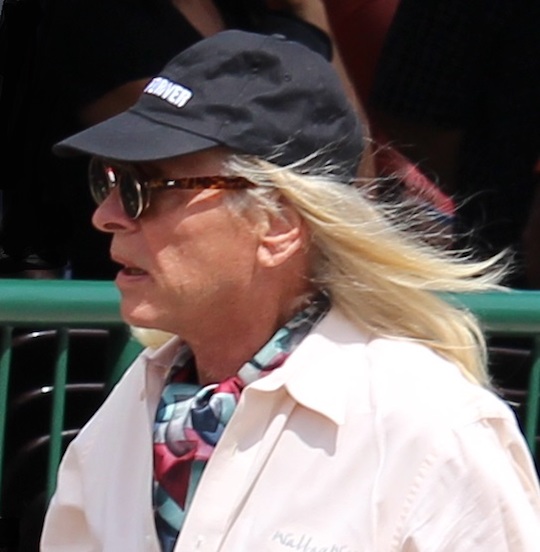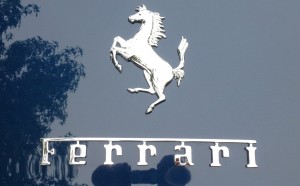by Wallace Wyss –
I consider the Ferrari 365 GTB/4 Daytona to be sort of a last exercise in chutzpah for ol’ Enzo. After all, Lamborghini had already introduced the mid-engine Miura, and all Ferraris factory race cars were mid-engined so what the hell was he doing introducing a front engine car again?
Some feel the Daytona was only a stopgap car until he could get the Boxer sorted out, that not only had a mid-engine but a flat twelve and was a difficult birth, shall we say.
In retrospect, even though it was obsolete as regards where the engine was, it is looked upon fondly as one of the last great front engine Ferraris.
Also another thing that makes it significant is that you could argue that it was built before Fiat was invited in to buy out Ferrari’s road car operation. Enzo had Henry Ford II ready to write a check for his outfit but negotiations stuck and he went to Fiat for a friendlier buyout.
The name of the car, curiously is not on the car but only applied at the last minute on the publicity because Ferrari had managed a 1-2-3 victory at Daytona with some prototypes in the 1967 Daytona 24 Hours.
There were two prototypes (chassis number 10287 and 11001) built on tubular chassis. The first, a covered headlight car, has the nose sticking out a tad more than the long nose 275 GTB. Ferrari and Pininfarina tended to build a running car and then play with the styling until it was finalized.
Originally the plan was to have the headlamps set in place and see through Perspex covers with a sheet of plexiglass in between the headlamps with fine lines on it. But that would never meet US laws, where we still had sealed beam headlights. So eventually the flip up headlamps were adopted, making those with documented fixed in place Perspex covered lamps more rare and valuable in the U.S.
The chassis was just an evolution of the 275 GTB/4, traditional welded tubular steel and even had the same 2400mm wheelbase.
But by this time Ferrari had discovered the joys and lightweight of fiberglass so the Daytona had an inner tub of fiberglass.
The engine looks a lot like a 275 GTB/4 four cam and it is but an enlarged Tipo 226 60° V12 with a new designation – Tipo 251. Size was moved up to from 3.3 to 4.4-liters. The hp figure for the time sounds impressive – 352 bhp at 7500 rpm, compression being relatively modest at 8.8:1.
Like the four cam 275 it had a half dozen twin-choke Weber carbs marching down the center, 40 DCN 20/21A carburetors on the American spec models while Euros packed 40 DCN 21.
The car had to be able to go 174 mph because that was the Miura’s top end. It would never do to have a car that couldn’t beat the cars by that upstart Ferruccio.
But it was a job to get it to that speed because the body except for doors, bonnet and boot lid was steel, tipping the scales at 3880 pounds. Some reports are that it was the world’s fastest production car.
The proportions of the car were impossibly long bonnet with the the cabin about two thirds of the way back, having a fastback leading down to a Kamm tail, chopped off with half inset taillights. The front was discreet in its use of scoops, actually being vented with two flush deck vents that extracted hot air. There were no side vents as there were on the 275GTB.
That’s why the car hasn’t dated. It is plain, but plainness is good; you don’t get tired of the same old scoops and vents. The interior, though, is dated by modern standards, and you wonder now about the choice of two tone upholstery on some of the cars. Or the famous fuzzy “mouse fur” on the dash. Old school was the wood-rimmed steering wheel.
The car rolled out into the sun at the October 1968 Paris Salon and was celebrated.
It didn’t have many options. There was A/C, needed with all that glass, and a Voxson radio (remember those?). Or if you were really worldly, Blaupunkt from Germany. You could order it with chrome plated Borrani wire wheels, or wider than normal Cromodora wheels.
If you wanted more power, supposedly Servizio Assistenza Clienti could tweak it up to 380 bhp. But truth was the engine was fully developed at stock and there wasn’t much more in it.
Ferrari had dropped the ball on the earlier 275 GTB by not introducing a Spyder with the same lines (the NART Spyder was ordered by Chinetti in America despite Enzo’s protestations). This time he made sure to have an authorized Spyder version.
Since America was the big market they made sure it had the Daytona with retractable headlights. Maybe in a homage to the Perspex version they ran a band of aluminum paint across the front, sort of silly match at a distance to Perspex cars.
Experts claim that only one genuine GTB/4 Spyder (Frankfurt Show car, chassis 12851) was ever built with the ill-fated soon to be dropped perspex nose. That car was yellow with chrome Borrainis.
There was a difference in turn signals if you got all orange or combination color lenses depending on where you lived. To satisfy the Feds, they had to change from aluminum to steel doors and at some point the original steering wheel was judged too big and downsized.
Though the Daytona is considered a 1974 car here, experts say that production stopped in ’73 so the Boxer could finally start down the Pininfarina assembly line.
The total number made reaches what I call the “magic number to make a car rare” (which is 1000 units) to be exact 1284 GTB/4’s, 179 of which were RHD for England, Australia and NZ.
The number of Spyders is usually listed as 121 (unless you want to add the prototype). An open Spyder is extremely rare in RHD, only seven were made.
Quite a few were cut subsequently by fabricators such as Richard Straman in Costa Mesa, CA. Some of the cut cars are ineptly done, so their value depends a lot on who did the cutting. Straman was one of the best but some of the English Spyder conversions are lauded.
None of the cut cars though, are worth what an original is. Ferrari magazines have published lists of the SN of the actual Spyders to prevent confusion but if you bid on one at an auction, you better be able to find that list.
One thing that boosted the value of the Daytona Spyder long after it was out of production was the featuring of a replica one in the TV series Miami Vice. It annoyed Ferrari so much they insisted that future seasons of the show have a real Testarossa instead.
Ferraris come and go, some of them not missed at all (Mondial 8 coupes?). But the Daytona Spyder, because they were the last production front engine road car “blessed by” Enzo, and they fought the good fight against Lamborghini though they were front engined is fondly remembered.
Let us know what you think in the Comments.
THE AUTHOR: The author, a fine artist, is working on concepts of transferring his painted portraits of classic cars to clothing. Interested retailers can reach him at Photojournalistpro2@gmail.com.







Ever stunning cars and the value is still there even in the current climate… while I personally think the coupes are prettier they do not have the cache commanded by an original spider… Iconic to say the least… And actually nice to drive… my recollection was they were about 3 times the cost of a new Corvette in the day…
Jim,
What do you think about the huge difference in value between an original Spyder and a converted Spyder?
I hope Jim has a good opinion on that. Nobody asked me but, as the original author, I’ll throw in my opinion. It all depends on who did the cutting. Straman did a lot of them and I think , being a former classic car restorer, he took his time and did it right. But his still should be valued at less than the factory ones because the factory ones were engineered to be spyders and built as spyders, not converted like some early Silver Cloud sedans, cut by the factory to be open cars. Also Straman’s spyder conversions were built out of time sequence, when the Daytonas were no longer being built. That should hurt the value compared to the originals. The other firms cutting coupes into spyders had varying degrees of quality, and I wouldn’t want to rate them unless I could drive them on a bumpy road to evaluate the degree of scuttle shake (yeah, and I expect the cars to be rolling up to my door soon)